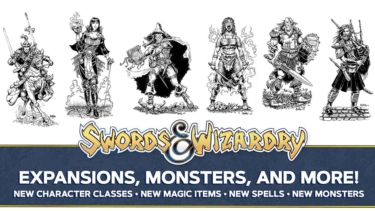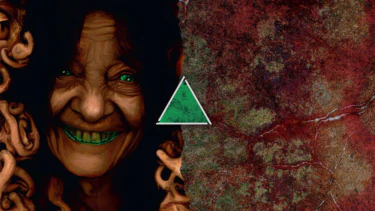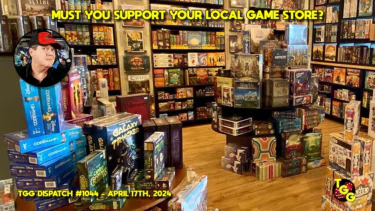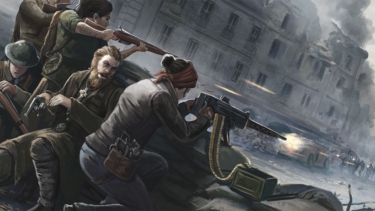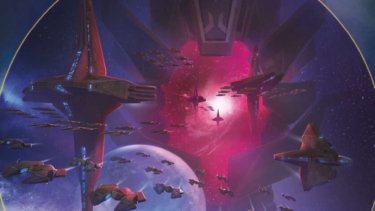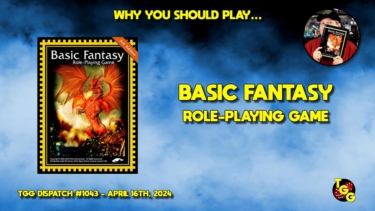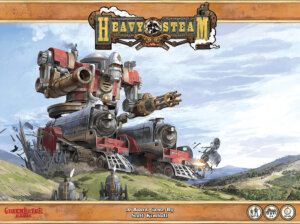
Publisher: Greenbrier Games
Designer: Scott Kimball
Year: 2015
Genre: Steampunk Victorian era game of tactical mech combat
Players: Two to four players
Ages: 12+
Playing Time: Around two hours
MSRP: $80.00
Outside the Box Video
I can happily say the game did get funded (obviously, since I’m reviewing it) and I’m very glad it did since it’s an excellent addition to any tactical gamers library.
Heavy Steam is set in an alternate steampunk history in which the three superpowers of this quasi-Victorian age are England, France, and Germany. Sorry to say we Yanks are left out in the cold since a meteor hit North America just as the American Revolution began and, well, we were sort of blasted out of existence before we could get around to rousting the Brits from the colonies. Soon after the meteor strike – known as The Great Blight – the three superpowers (or what was left of the superpowers) began experimenting with a new and nearly miraculous compound called zenjin. This material could be used as a more efficient fuel source for machines or combined with metals to create materials stronger than steel.
Of course what does man do when he discovers something revolutionary? He tries to find ways to weaponize it!
So began a weapons race of sorts between the newly formed UK Alliance (Britain and her former colonies and allies) and the Central European Trust (composed of France, Germany, and countries not aligned with the UK) to create bigger and more destructive weapons of war. Thus the Steam Titans were born and now both factions are ready to square off. The game fiction essentially presents the UK Alliance as the good guys but my take on this fictional reality is more in tune with real history; all parties involved are for the most part dirty, colonizing land grabbers. Plus, I hate when a fictional setting has to throw someone into the role of “the bad guys” since a lot of people don’t want to represent the baddies.
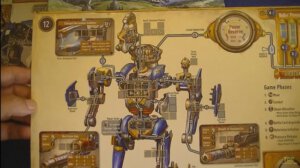
There are a lot of moving parts under the hood of Heavy Steam so I’m not going to go through an entire recap of the rules. I will mention the rules are a bit longer than most casual gamers might be used to – clocking in at thirty pages or so – and it will be important to read the book thoroughly before you begin your first stab at the game. Be sure to keep the rules nearby because you’ll more than likely need to refer to them as you play your first few turns.
Players win begin by selecting from one of the five scenarios, picking a faction, choosing a Titan (the scenario will indicate if you can use heavy or light Titans), customizing the Titan, and deciding which Pilot card you’ll use. The pilots have special abilities and one single use ability as well. Players will then begin to set up their Titan layout by using the cubes. White cubes represent steam, blue are shields, red are heat, and black are damage. Then the Battle Board is laid out between the players and the Battle Deck is selected. The Battle Deck contains special events, infantry, mobile cannons, modifiers, terrain, and so on. In a way the deck itself represents the fortunes of war during that fight. Each player will receive three cards to begin (prior to three randomly selected Special Event cards being inserted into the deck) and an Enemy in Sight card is placed on the Battle Board corresponding to the number of players. I.E. two players mean two Enemy in Sight cards are placed in their areas.
Special mention has to be made of the Battle Board. While the steam allocation, damage placement, weapons and so forth are rather detailed the battlefield itself is abstracted. In essence it’s simply made up of range bands between the combatants. I’m sure a few people might think this is odd and the designer certainly should have gone the way of a hex map. I have to say I completely understand the reasoning (or what I think would be the reasoning) of the decision to use these simple range bands.
First, if you were to use a hex map then that means having to create multiple maps representing specific terrain elements on the battlefield or manufacturing counters that you would lay onto the map to represent terrain and so forth. This would undoubtedly lead to an increase in the cost of the game. Second, some people see a hex map and automatically jump to the conclusion that they must be looking at a traditional hex and counter sort of game. A lot of those people think hex and counter games are too old school, or boring, or overly complex and that might have prevented folks from giving Heavy Steam a try.
Once everything has been set up then the players roll to see who has initiative in the first round; Heavy Steam is played in rounds which are broken down into phases. The player or team with initiative will move first, get the first shot off in combat, allocate steam before the other side, and have the first crack at buying a Battle Card. There are six phases to each round:
Move – Self-explanatory as the side with initiative will move all of their Titans, as well as support units, and/or play terrain cards before the other. Titans must move to play a terrain card.
Combat – This is the down and dirty as players take turns firing weapons, engaging in close combat, using infantry or mobile cannons, and/or playing cards to inflict damage on the enemy. Keep in mind you’re taking turns with each weapon (or support unit) and not each Titan.
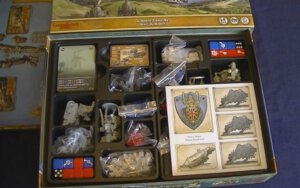
The way damage is allocated across the layout reminded me a little of Steve Jackson’s Car Wars or the old Task Force Games Star Fleet Battles (as in the SFB before it became this nearly unplayable behemoth of rules). I’m not saying it’s exactly the same but the way damage carries through and systems fail or get blown off has that same sort of vibe.
Allocate Steam – This is probably the trickiest part of Heavy Steam. Steam flows through the Titan and you have to adhere to how the cubes are supposed to move throughout the machine. Rather than getting into too much detail the minutia let’s just say you need to constantly be planning your actions in advance; steam takes time to reach the extremities of the Titan and each round you have to move the cubes according to the flow. You have to be careful too because you don’t want to have your boiler pressure get too high or overheat your Titan. Repairs also take place during the Steam Allocation phase and the side with initiative always allocates the steam to all of their Titans before the other side.
Steam is allocated to various stations to allow the Titan to operate. This steam is used to move the Titan, or fire weapons, or help you win initiative and buy Battle Cards, or repair damage. You’ll never have enough Steam to do everything you want to do so it’s crucial that you’re planning at least a round ahead.
Buy Battle Cards – Players can purchase available Battle Cards in initiative order. When you set up the game you’ll have already drawn, and placed face up, four Battle Cards which can be bought with steam allocated to the Command Center area of the Titan. Where the card is in line determines the cost. One a single Battle Card can be played by each player per phase and some cards may only be played at specific times. Event Cards aren’t purchased but come into effect if they’re drawn while replenishing the available Battle Cards.
Determine Initiative – The next round’s initiative is determined by seeing who allocated the most steam to their Command Center. In the case of a tie the side which didn’t have the initiative will now have it in the upcoming round. The team with initiative also gets to freely move two steam cubes on each of their Titans.
Pressure Phase – The final phase of the round will have players checking to see if the pressure that’s built up in their boiler rooms causes an overload. Overloads can cause damage to the Titan’s Boiler Room. Players also release pressure from the boilers and can use steam vents as well.
As I mentioned earlier, there’s a lot going on in this design and there are plenty of smaller details I’ve left out for the sake of keeping this review shorter than a novella. This doesn’t mean Heavy Steam is an overly complex game though since once you get the hang of the phases, and how the pieces fit together, the game settles into a nice rhythm. It’s just wrapping your head around how the steam flows, damage allocation, and where all these little cubes are moving around to that might throw you off in your first battle.
I happen to think Heavy Steam is an excellent game. I’ve had a lot of fun playing and it’s only after you get a handle on the rules and put a couple of games under your belt that some of the interesting strategies at hand and intricacies of the design come to light. I’ll share a few helpful tips.
Pay attention to your opponent: If you don’t have the initiative you’re going to allocate your steam second. It’s critical that you watch to see what the other side is doing with their Titans. Steam allocation isn’t hidden so you can see exactly what the other team is going to try to accomplish. Of course I’ve mentioned you want to be continually planning ahead but seeing your opponent trying to power up all their weapons or needing to use steam toward critical repairs can really give you a leg up in how you plan to allocate your steam.
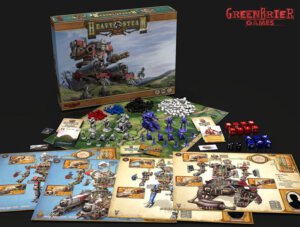
Don’t underestimate the importance of the Command Center: Sure, putting steam cubes into the Command Center helps you grab that important initiative but the CC can help you in other ways too. You have to use cubes from the CC to buy Battle Cards and you can also use CC steam to reroll hit locations. Didn’t I just mention weak spots and volatile weapons. Maybe you’d like to reroll that critical hit to see if you can make that flamethrower explode?
Buy Battle Cards: There’s a whole lot of luck involved in Heavy Steam, what with all the dice rolling and random Battle Cards you’re dealt and available to buy, and getting your hands on Battle Cards helps put more of that luck in your corner. The cards are also the only way you’ll have access to infantry and cannons.
Infantry and Mobile Cannons are your friends: Yes, the focus of Heavy Steam is on big old Titans battling it out! Yet, infantry and mobile cannons can be the difference between winning and losing. While your opponent is busy fending off the pipsqueaks you can buy more time to effect repairs, get steam to stations where you need it, and continue to smartly plan your attacks. Plus your support units deal out damage too and you never know where that fateful shot that takes down your opponent’s heavy Titan might come from.
I have to say I’m really glad that Heavy Steam made it to market. The battles are really nip and tuck if you pay attention to the big picture of what’s happening in the game and play smart. The steam allocation is a very clever mechanic to drive the game and works really well once you understand how it does work. I’ve had a blast with the game and look forward to the possibility of some additional expansions with more Titan classes to add to the proceedings. I know Greenbrier has released a pilot pack and a weaponry pack but nothing as far as new Titan designs.
I don’t toss extremely high review scores around lightly and my only quibbles with the game are the card stock Titan layouts and, as I mentioned in the video, the pith helmet on the UK Titans just strikes me as silly in what’s an otherwise straightforward and serious fictional setting. I know the folks out there who take issue with games which involve a lot of dice rolling and *gasp* luck might not be so keen to give Heavy Steam a go but for anyone interested in a cool tactical steampunk mech game, with some interesting new mechanics, this is a must buy.





